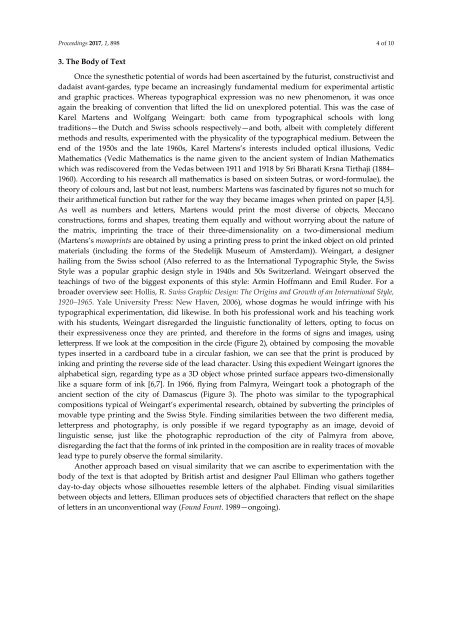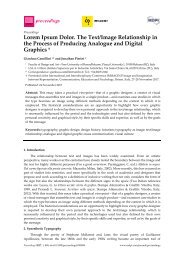proceedings-01-00898
You also want an ePaper? Increase the reach of your titles
YUMPU automatically turns print PDFs into web optimized ePapers that Google loves.
Proceedings 2<strong>01</strong>7, 1, 898 4 of 10<br />
3. The Body of Text<br />
Once the synesthetic potential of words had been ascertained by the futurist, constructivist and<br />
dadaist avant-gardes, type became an increasingly fundamental medium for experimental artistic<br />
and graphic practices. Whereas typographical expression was no new phenomenon, it was once<br />
again the breaking of convention that lifted the lid on unexplored potential. This was the case of<br />
Karel Martens and Wolfgang Weingart: both came from typographical schools with long<br />
traditions—the Dutch and Swiss schools respectively—and both, albeit with completely different<br />
methods and results, experimented with the physicality of the typographical medium. Between the<br />
end of the 1950s and the late 1960s, Karel Martens’s interests included optical illusions, Vedic<br />
Mathematics (Vedic Mathematics is the name given to the ancient system of Indian Mathematics<br />
which was rediscovered from the Vedas between 1911 and 1918 by Sri Bharati Krsna Tirthaji (1884–<br />
1960). According to his research all mathematics is based on sixteen Sutras, or word-formulae), the<br />
theory of colours and, last but not least, numbers: Martens was fascinated by figures not so much for<br />
their arithmetical function but rather for the way they became images when printed on paper [4,5].<br />
As well as numbers and letters, Martens would print the most diverse of objects, Meccano<br />
constructions, forms and shapes, treating them equally and without worrying about the nature of<br />
the matrix, imprinting the trace of their three-dimensionality on a two-dimensional medium<br />
(Martens’s monoprints are obtained by using a printing press to print the inked object on old printed<br />
materials (including the forms of the Stedelijk Museum of Amsterdam)). Weingart, a designer<br />
hailing from the Swiss school (Also referred to as the International Typographic Style, the Swiss<br />
Style was a popular graphic design style in 1940s and 50s Switzerland. Weingart observed the<br />
teachings of two of the biggest exponents of this style: Armin Hoffmann and Emil Ruder. For a<br />
broader overview see: Hollis, R. Swiss Graphic Design: The Origins and Growth of an International Style,<br />
1920–1965. Yale University Press: New Haven, 2006), whose dogmas he would infringe with his<br />
typographical experimentation, did likewise. In both his professional work and his teaching work<br />
with his students, Weingart disregarded the linguistic functionality of letters, opting to focus on<br />
their expressiveness once they are printed, and therefore in the forms of signs and images, using<br />
letterpress. If we look at the composition in the circle (Figure 2), obtained by composing the movable<br />
types inserted in a cardboard tube in a circular fashion, we can see that the print is produced by<br />
inking and printing the reverse side of the lead character. Using this expedient Weingart ignores the<br />
alphabetical sign, regarding type as a 3D object whose printed surface appears two-dimensionally<br />
like a square form of ink [6,7]. In 1966, flying from Palmyra, Weingart took a photograph of the<br />
ancient section of the city of Damascus (Figure 3). The photo was similar to the typographical<br />
compositions typical of Weingart’s experimental research, obtained by subverting the principles of<br />
movable type printing and the Swiss Style. Finding similarities between the two different media,<br />
letterpress and photography, is only possible if we regard typography as an image, devoid of<br />
linguistic sense, just like the photographic reproduction of the city of Palmyra from above,<br />
disregarding the fact that the forms of ink printed in the composition are in reality traces of movable<br />
lead type to purely observe the formal similarity.<br />
Another approach based on visual similarity that we can ascribe to experimentation with the<br />
body of the text is that adopted by British artist and designer Paul Elliman who gathers together<br />
day-to-day objects whose silhouettes resemble letters of the alphabet. Finding visual similarities<br />
between objects and letters, Elliman produces sets of objectified characters that reflect on the shape<br />
of letters in an unconventional way (Found Fount. 1989—ongoing).



